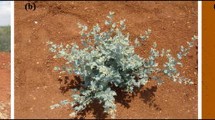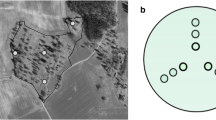Abstract
Shrublands with kermes oak (Quercus coccifera L.) as a dominant species play an important role in the nutrition of grazing animals in the Mediterranean region during all seasons of the year. Their proper management, however, is inhibited by the lack of easy and inexpensive methods for measuring available forage. In this paper, the spatial distribution of available forage as well as its relationship with shrub cover measured on the ground and in aerial photographs were investigated. The research was conducted in kermes oak shrublands of central Macedonia, Greece. Two-phase sampling was applied by using 1:15,000 aerial photographs to select 47 plots, 0.1 ha each, on an area of 545 ha where shrub cover and available forage (herbage, current year's and total browse) were measured. These measurements were carried out on four shrub cover classes: open (0 to 15%), moderate (16 to 40%), dense (41 to 70%) and very dense (71 to 100%); and three height classes: low (0 to 0.5 m), middle (0.6 to 1.0 m) and tall (1.1 to 1.5 m). High resolution aerial photographs (1:6,000) taken during the year of ground sampling were used to estimate shrub cover and correlate to ground measurement. Estimated cover had a high correlation (r≥ 0.96) with ground measurements in open, moderate and dense shrub stands. The open to dense cover classes had significantly more available forage than the very dense cover class; and the low height class significantly higher than the other two classes. The regression of available forage with shrub cover measured on the ground and on aerial photographs produced non-linear equations with high coefficients of determination (R2 > 0.70) only when shrub height up to 0.5 m irrespective of the cover class was considered. It is concluded that shrub cover measured on aerial photographs can be used to predict shrub cover on the ground as well as available forage in kermes oak shrublands provided that the shrubs are not too tall (up to 0.50 m).
Similar content being viewed by others
References
Bobek B. and Bergrostrom R. 1978. A rapid method of browse biomass estimation in a forest habitat. J Range Manage 31: 456–458.
Cochran W.G. 1977. Sampling Techniques. 3rd edn. Wiley, New York, NY.
Cook C.W. and Stubbendieck J. 1986. Range Research: Basic Problems and Techniques. Soc for Range Management, Denver, CO.
Dafis S. 1973. Classification of Forest Vegetation of Greece. Scientific Anniversary of Agric. and Forest School, IE(B), Thessaloniki, Greece, (in Greek).
Draper N.R. and Smith H. 1966. Applied Regression Analysis. John Wiley and Sons, Inc, New York, NY.
Etienne M. 1989. Non destructive methods for evaluating shrub biomass: A review. Acta Ecologica/Ecologia Applicata 10: 115–128.
Gong P., Bising G.S. and Standiford R. 2000. Use of digital surface model for hardwood rangeland monitoring. J Range Manage 53: 622–626.
Hagan G.F. and Smith J.I. 1986. Predicting tree groundline diameter from crown measurements mode on 35 mm aerial photograph. Photogrammetrics Eng and Remote Sensing 52: 687–690.
Hierro J.L., Branch L.C., Villarreal D. and Clark K.L. 2000. Predictive equations for biomass and fuel characteristics of Argentine shrubs. J Range Manage 53: 617–621.
Karteris M. 1990. Forest Aerial-photograph. Aristotle Univ, Univ Studio Press, Thessaloniki, Greece.
Le Houerou H.N. 1983. The role of browse in the management of natural grazing lands. In: Le Houerou H.N. (ed.), Proc. Int. Symposium on Browse in Africa, the Current State of Knowledge. Addis Ababa, Ethiopia, pp. 329–338.
Neyman J. 1938. Contribution to the theory of sampling human populations. Jour Amer Stat Assoc 33: 101–106.
Papachristou T.G. and Nastis A.S. 1993a. Nutritive value of diet selected by goats grazing on kermes oak shrublands with different shrub and herbage cover in Northern Greece. Small Rum Research 12: 35–44.
Papachristou T.G. and Nastis A.S. 1993b. Diets of goats grazing at shrublands of varying cover in northern Greece. J Range Manage 46: 220–226.
Papachristou T.G., Platis P.D. and Papanastasis V.P. 1997. Forage production and small ruminant grazing responses in Mediterranean shrublands as influenced by the reduction of shrub cover. Agrofor Syst 35: 225–238.
Papanastasis V. and Liacos L. 1991. Effects of kermes oak brushland improvement on vegetation and live weight gains of goats in Greece. In: Gaston A., Kermick M. and Houerou H.N.L. (eds), 4th Int. Rangeland Cong. CIRAD, Montpellier, France, pp. 850–853.
Platis P.D. 1994. Vegetation cover distribution and available production in kermes oak shrublands and its estimation by the use of aerial photographs. PhD Dissertation, Aristotle Univ of Thessaloniki, Greece.
Steel R.G.D. and Torrie J.H. 1980. Principles and Procedures of Statistics. 2nd edn. McGraw-Hill Book Co Inc, New York, NY.
Strong L.L., Dana R.W. and Carpenter L.H. 1985. Estimating phytomass of sagebrush habitat types from microdensitometer data. Photogrammetrics Eng and Remote Sensing 51: 467–474.
Tadmor N.H., Brieghet A., Meir I.N., Benjamin R.W. and Eyal E. 1975. An evaluation of the calibrated weight-estimate method for measuring production in annual vegetation. J Range Manage 28: 65–69.
Thompson J.E. 1982. Photo interpretation for structure classification of tree-dominated vegetation. Australian Forest Res 12: 71–74.
Tueller P.T. 1982. Remote sensing for range management. In: Johannsen C.J. and Sanders J.C. (eds), Remote Sensing for Resource Management. Reno, Nev, USA, pp. 125–140.
Tutin T.G., Heywood V.H., Burges N.A., Moore D.M., Valentine D.H., Walters S.M. et al. 1980. Flora Europaea. Cambridge Univ Press, UK.
Yiakoulaki M.D. and Nastis A.S. 1987. Nutritive value of range species as dtermined with laboratory procedures and their contribution to meet animal demands. Scientific Annues of the Dissertation of Forestry and Natural Environment L(10): 379–409.
Yiakoulaki M.D. and Nastis A.S. 1995. Intake by goats grazing kermes oak shrublands with varying cover in Northern Greece. Small Rum Research 17: 223–228.
Author information
Authors and Affiliations
Rights and permissions
About this article
Cite this article
Platis, P., Papanastasis, V. Relationship between shrub cover and available forage in Mediterranean shrublands. Agroforestry Systems 57, 59–67 (2003). https://doi.org/10.1023/A:1022908408183
Issue Date:
DOI: https://doi.org/10.1023/A:1022908408183




